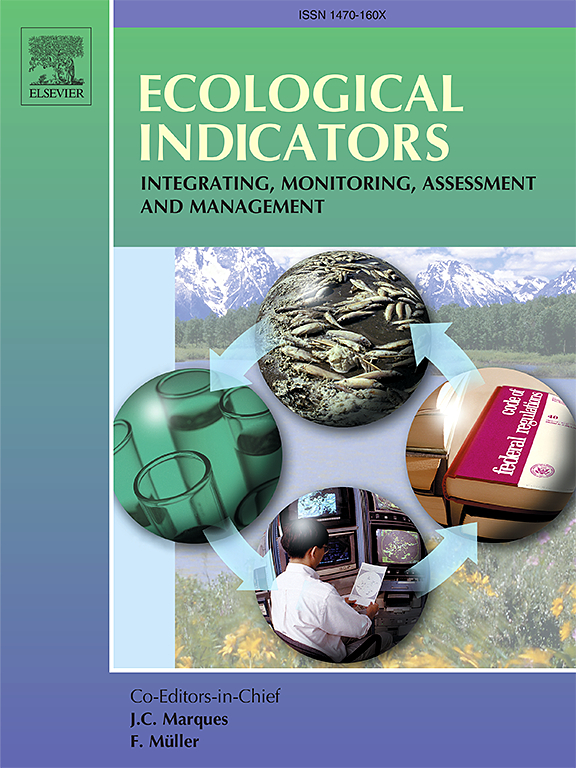Analysis of spatial network characteristics in the coupling coordination between global industrial structure optimization and carbon emission efficiency
IF 7
2区 环境科学与生态学
Q1 ENVIRONMENTAL SCIENCES
引用次数: 0
Abstract
This study constructs a spatial network framework for the coupling and coordination of industrial structure optimization (ISO) and carbon emission efficiency (CEE) using data from 133 countries globally between 2007 and 2021. By integrating the CRITIC weighting method, four-stage DEA model, improved coupling coordination degree model (CCDM), social network analysis (SNA), and Spatial Durbin Model (SDM), the research reveals the spatiotemporal evolution, structural characteristics, and driving mechanisms of ISO-CEE interactions. Key findings include: (1) Global CCD increased by 6.5 % from 2007 to 2021, peaking at 0.430 in 2021. Nevertheless, 54.89 % of countries remain in an uncoordinated state, reflecting a pattern of “high-income dominance with middle- and low-income lag.” China achieved a leap in CCD (from 0.533 to 0.714) through “institutional leverage,” highlighting the critical role of policy-technology synergy in overcoming coordination challenges. (2) Network analysis uncovers a “core-periphery” hierarchical structure. HI (e.g., Norway, the U.S.) dominate network hubs (coreness ≥ 0.1), controlling 65 % of betweenness centrality, while LI face structural disparities between technology inflow (in-degree) and network influence (betweenness). This centralized topology heightens systemic vulnerability to policy shocks. (3) TOT, TA, RQ, and GDP per capita significantly impact CCD, whereas GE and FDI show no significant effects. The SDM confirms heterogeneous drivers: RQ exerts differential effects across income levels; FDI induces “carbon leakage” in developing regions; and technological innovation lacks spatial spillover due to knowledge diffusion barriers. Based on these findings, the study proposes targeted policy recommendations, offering an empirical pathway for shifting global low-carbon governance from “unipolar vulnerability” to “multipolar resilience.”
全球产业结构优化与碳排放效率耦合协调的空间网络特征分析
利用2007 - 2021年全球133个国家的数据,构建了产业结构优化(ISO)与碳排放效率(CEE)耦合协调的空间网络框架。通过整合CRITIC加权法、四阶段DEA模型、改进耦合协调度模型(CCDM)、社会网络分析(SNA)和空间Durbin模型(SDM),揭示了ISO-CEE相互作用的时空演化、结构特征和驱动机制。结果表明:(1)2007 - 2021年全球CCD增长6.5%,在2021年达到峰值0.430;然而,54.89%的国家仍处于不协调状态,反映出“高收入占主导地位,中低收入落后”的格局。中国通过“制度杠杆”实现了CCD的飞跃(从0.533到0.714),突出了政策-技术协同在克服协调挑战方面的关键作用。(2)网络分析揭示了“核心-外围”的层次结构。高发达国家(如挪威、美国)主导着网络枢纽(核心度≥0.1),控制着65%的中间度中心性,而低发达国家则面临着技术流入(程度)和网络影响(中间度)之间的结构性差异。这种集中式拓扑结构增加了系统对策略冲击的脆弱性。(3) TOT、TA、RQ和人均GDP对CCD影响显著,GE和FDI对CCD影响不显著。SDM证实了异质性驱动因素:RQ对不同收入水平的影响是不同的;FDI导致发展中地区“碳泄漏”;由于知识扩散障碍,技术创新缺乏空间溢出效应。基于这些发现,本研究提出了有针对性的政策建议,为全球低碳治理从“单极脆弱性”向“多极韧性”转变提供了经验路径。
本文章由计算机程序翻译,如有差异,请以英文原文为准。
求助全文
约1分钟内获得全文
求助全文
来源期刊

Ecological Indicators
环境科学-环境科学
CiteScore
11.80
自引率
8.70%
发文量
1163
审稿时长
78 days
期刊介绍:
The ultimate aim of Ecological Indicators is to integrate the monitoring and assessment of ecological and environmental indicators with management practices. The journal provides a forum for the discussion of the applied scientific development and review of traditional indicator approaches as well as for theoretical, modelling and quantitative applications such as index development. Research into the following areas will be published.
• All aspects of ecological and environmental indicators and indices.
• New indicators, and new approaches and methods for indicator development, testing and use.
• Development and modelling of indices, e.g. application of indicator suites across multiple scales and resources.
• Analysis and research of resource, system- and scale-specific indicators.
• Methods for integration of social and other valuation metrics for the production of scientifically rigorous and politically-relevant assessments using indicator-based monitoring and assessment programs.
• How research indicators can be transformed into direct application for management purposes.
• Broader assessment objectives and methods, e.g. biodiversity, biological integrity, and sustainability, through the use of indicators.
• Resource-specific indicators such as landscape, agroecosystems, forests, wetlands, etc.
 求助内容:
求助内容: 应助结果提醒方式:
应助结果提醒方式:


